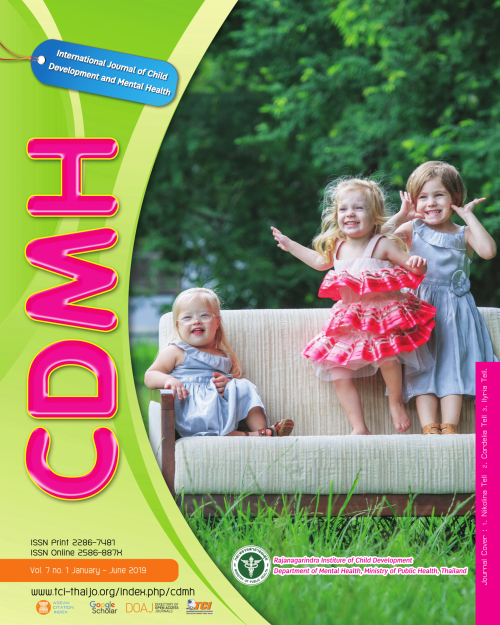The Effect of Integration Activities for Reduction Repetitive Behaviors in Children with Autism
Main Article Content
Abstract
This study aims to determine the effectiveness of integrated activities to reduction repetitive behavior in children with autism. The participants were students, age ranged from 4 – 10 years old, who were clinically diagnosed as autism and enrolled at Special Education Center, Loei Province. Research was single subject design with AB design. The participants were selected by purposive sampling. Over the course of 13 weeks of the study, integrated activities were designed for individual program for reduction repetitive behaviors that were negative effect to learning. These behaviors include head butting, hand flapping, finger knocking, finger banding, body shaking and hand gesturing. The behaviors in academic class were video recorded for further analysis where the frequency of the behaviors can be recorded at 1st (A), 5th (B5), 9th (B9), and 13rd (B13) Week. Video recordings were individually replayed by 2 evaluators (inter-observer reliability = 98.3%), the main researcher and research assistant who are teaching special educators and counted number of repetitive behaviors. Data were consensused and analyzed by using descriptive analysis for general information and The Wilcoxon Signed- Rank Test for analysis median difference among number of repetitive behaviors at A1, B5, B9, and B13. The result revealed that integration activities significantly decreased repetitive behaviors for children with autism between the 1st (A) and 13rd (B13) week (Median difference = -32.5, 95% confidence interval = 24.09-38.78).
Article Details
![]()
Creative Commons License
This work is licensed under a Creative Commons Attribution-NonCommercial-No Derivatives 4.0 International (CC BY-NC-ND 4.0)
The authors retain copyright and permit the journal the copyright of first publication
Articles, once having passed the review process and accepted for publication in the CDMH Journal, are copyrighted under the CDMH Journal, Department of Mental Health, Ministry of Public Health. Please be aware distribution of CDMH Journal content for commercial purposes without permission is expressly prohibited. However, distribution with intent to educate, advocate, or spread awareness within the general public and research communities is permitted and encouraged with the understanding that the CDMH Journal Editorial Board do not hold jurisdiction or liability for any accompanying comments, text, or information from third parties, either in favor for or against the original article’s assertions, conclusions, methodology, or content.
References
with autism. Egyptian Journal of Medical Human Genetics, 16(4), 375-380.
American Psychiatric Association. (2013). Diagnostic and statistical manual of mental disorders (5th ed.). Arlington:
American Psychiatric Publishing.
Daly, M. J., Rioux, J. D., Schaffner, S. F., Hudson, T. J., & Lander, E. S. (2001). High-resolution haplotype structure in
the human genome. Nature genetics, 29(2), 229.
Eikeseth,S. (2009). Outcome of comprehensive TEACCH program for young children with autism. Research in
Developmental Disabilities, 30(1), 158-178.
Fertel-Daly, D., Bedell, G., & Hinojosa, J. (2001). Effects of a weighted vest on attention to task and self-stimulatory
behaviors in preschoolers with pervasive developmental disorders. The American Journal of Occupational
Therapy, 55, 629–640
Insel, T. R., O’Brien, D. J., & Leckman, J. F. (1999). Oxytocin, vasopressin, and autism: is there a connection?
Biological Psychiatry, 45(2), 145-157.
Juanongwaeng, S. (2012). Using Sensory Motor Activities to Reduce Fingers Flickingin a Child with Autism. (Master’s
Thesis). Chiang Mai University. Chiang Mai (In Thai).
Karim AEA *, Mohammed AH. (2015). Effectiveness of sensory integration program in motor skills in children with
autism. The Egyptian Journal of Medical Human Genetics 16, 375–380.).
Kim, H. H., Bo, G. H., & Yoo, B. K. (2012). The Effects of a Sensory Integration Programme with Applied Interactive
Metronome Training for Children with Developmental Disabilities: A Pilot Study. HongKong Journal of Occupational
Therapy, 22(1), 25-30.
Leong, H., Carter, M., & Stephenson, J. (2015). Systematic review of sensory integration therapy for individuals with
disabilities: Single case design studies. Research in Developmental Disabilities, 47, 334-351
Lai, M. C., Lombardo, M. V., Chakrabarti, B., & Baron-Cohen, S. (2013). Subgrouping the Autism “Spectrum":
Reflections on DSM-5. PLoS biology, 11(4), e1001544.
Mattila, M., Kielinen, M., Linna, S., Jussila, K., Ebeling, H., Bloigu, R., … Moilanen, I. (2011). Autism Spectrum
Disorders According to DSM-IV-TR and Comparison With DSM-5 Draft Criteria: An Epidemiological Study. Journal
of the American Academy of Child & Adolescent Psychiatry, 50(6), 583-592.e11.
Mandell, D. S., Novak, M. M., & Levy, S. (2005). Frequency and correlates of treatment use among a community
sample of children with autism. CA: San Diego.
Mesibov, G. B., & Shea, V. (2009). The TEACCH Program in the Era of Evidence-Based Practice. Journal of Autism
and Developmental Disorders, 40(5), 570-579.
Prathanee, B., (Ed). (2011). Autism: Speech Therapy and Interprofessional. Khon Kaen : Khon Kaen University.
(In Thai).
Raulston, T. J., Hansen, S. G., Machalicek, W., McIntyre, L. L., & Carnett, A. (2019). Interventions for Repetitive
Behavior in Young Children with Autism: A Survey of Behavioral Practices. Journal of autism and developmental
disorders, 1-13.
Saenthaweesuk, S. et al. (2011). Occupational Therapy and Sensory Integration for Autistic Child.( Annaoffset.) Khon
Kaen University. Khon Kaen. (In Thai)
Siriratrekha, T. (2017). Autism Spectrum Disorder : Educational Rehabilitation. Retrieved from
http://www.happyhomeclinic.com/au22-autism-care-iep.html
Sorntamart, O., (2015). Utilisation of Cyclic Model Movement Activities Based on the Sensory Integration Theory to
Reduce Repetitive Behaviors in a Child with Autism During Preparatory Stage (Master’s Thesis). Khon Kaen
University. Khon Kaen. (In Thai).
Sudalak, C., (2012). Reduction of Repeated Behavior of Autistic Children by Optical Structure Exercise under
TEACCH Method (Master’s Thesis). Suan Dusit Rajabhat University. Bangkok. (In Thai).
Vargas, S., & Camilli, G. (1999). A Meta-Analysis of Research on Sensory Integration Treatment. American Journal of
Occupational Therapy, 53(2), 189-198.
Wolff, J. J., Swanson, M. R., Elison, J. T., Gerig, G., Pruett, J. R., & Piven, J. (2017). Neural circuitry at age 6 months
associated with later repetitive behavior and sensory responsiveness in autism. Molecular Autism, 8(1).

